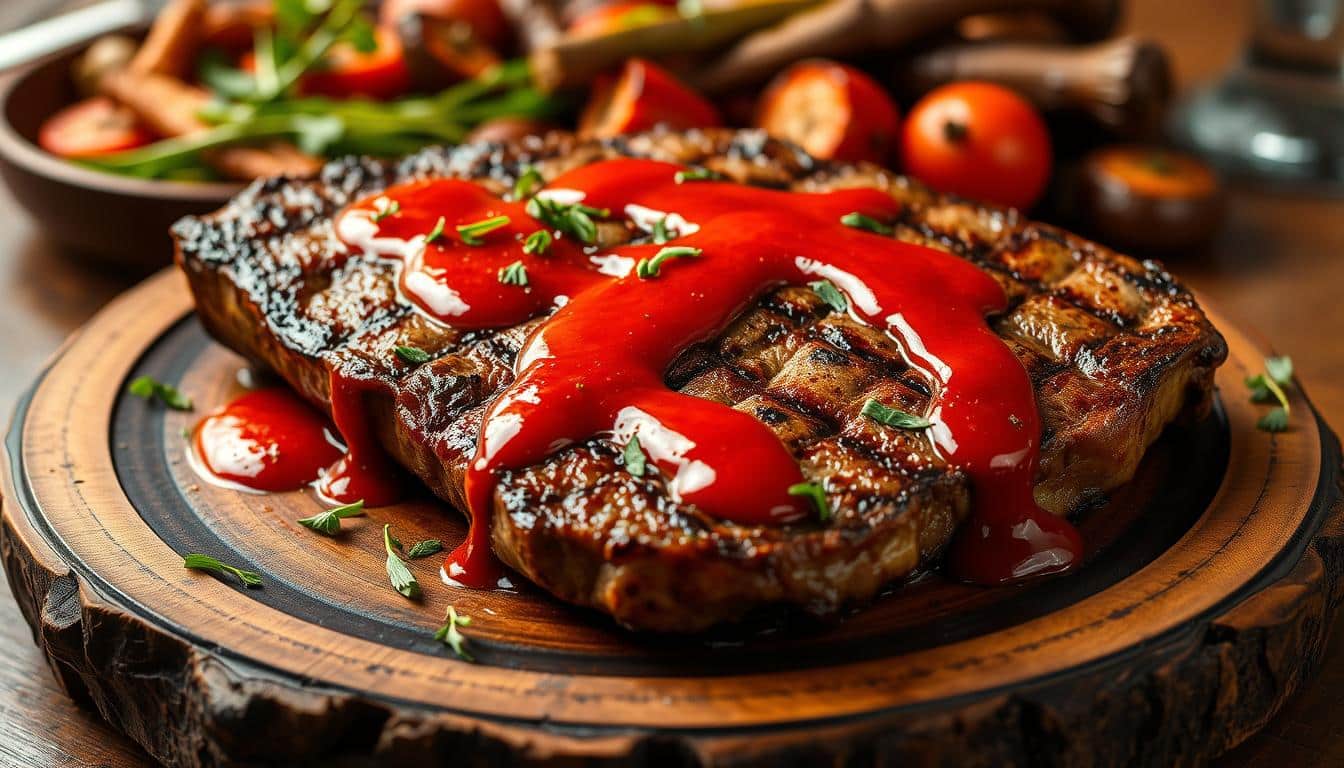Join us as we explore Spanish cuisine with a classic dish. It’s called Spanish steak with romesco sauce. This beef recipe shows the rich flavors of the Mediterranean.
This meal pairs tender, grilled beef with a nutty pepper sauce. It’s a great example of Spanish tapas culture. You’ll learn how to make it at home.For another flavorful steak recipe, explore our Discover Authentic Steak Milanesa Recipe, a breaded favorite from Latin cuisine. View Recipe.
Ready to take a culinary trip to Spain? Let’s learn how to make this tasty Spanish steak with romesco sauce.
The Rich Heritage of Spanish Steak Traditions
Spanish cuisine loves grilled meat a lot. This tradition has grown over centuries. It has shaped the country’s food and culture.
Origins in Catalonian Cuisine
The start of Spanish steak is in Catalonian cuisine. In this area, grilling was perfected. This laid the base for a national love for grilled meat.
Catalonia’s location by sea and mountains gave it many ingredients. These influenced the flavors of Spanish steaks today.
Evolution of Spanish Grilling Techniques
Spanish grilling has changed a lot over time. It went from simple open-fire cooking to advanced grills. This change kept traditions alive while adding new things.
This evolution brought out smoky flavors and tender textures. These are key to Spanish steaks.
Cultural Significance in Spanish Gastronomy
Grilled meat is very important in Spanish food. It’s more than just food; it’s a time for families and friends to come together. Grilling is a cherished tradition, filled with laughter and memories.
| Region | Signature Steak Dish | Key Ingredient |
|---|---|---|
| Catalonia | Bistec a la Catalana | Garlic and Parsley |
| Basque Country | Txuleton | Aged Beef |
| Galicia | Chuletón | Local Rubia Gallega Beef |
Exploring Spanish cuisine, we’ll see how these traditions shape our Spanish steak with Romesco sauce. This dish shows the heart of this rich culinary heritage.
Essential Ingredients for Spanish Steak with Romesco Sauce
Making the perfect Spanish steak with romesco sauce needs the right ingredients. We’ve put together a guide to help you make this delicious dish. It’s sure to wow your dinner guests.
Selecting the Perfect Cut of Beef
For real Spanish beef recipes, pick ribeye or sirloin. These cuts are full of flavor and tender. Look for beef that’s bright red with white fat. Steaks about 1-inch thick work best.
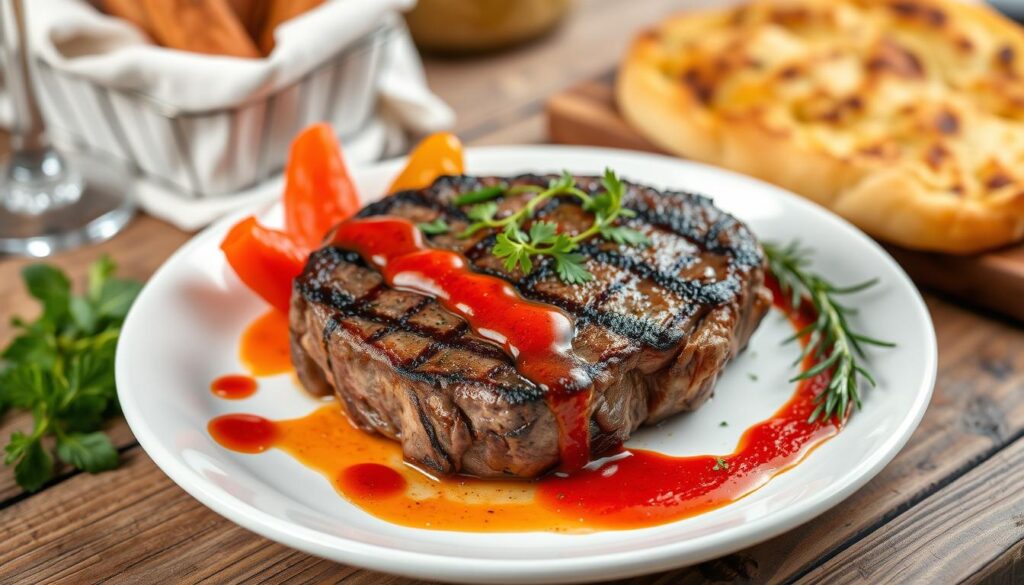
Traditional Romesco Sauce Components
Romesco sauce, a Catalan almond sauce, is the main attraction. It needs:
- Roasted red peppers
- Tomatoes
- Garlic
- Almonds
- Olive oil
- Sherry vinegar
- Smoked paprika
Blend these to make a smooth, tasty sauce. It will match the beef perfectly.If you enjoy slow-cooked dishes, try our Steak Osso Buco Recipe, a rich and tender braised shank. View Recipe.
Fresh Herbs and Seasonings Guide
Add these herbs and seasonings to your Spanish steak:
- Fresh rosemary
- Thyme
- Sea salt
- Cracked black pepper
- Smoked paprika
Season the steak with these before grilling. It will taste like Spain. The mix of great beef, rich sauce, and herbs will take you there.
Crafting Authentic Romesco Sauce
Romesco sauce is a tasty Spanish condiment that makes any dish better. We’ll show you how to make this yummy sauce step by step.
Begin by roasting red bell peppers and tomatoes until they’re charred. This step makes them sweeter. Then, peel and seed the peppers and blend them with the tomatoes.
Add garlic, toasted almonds, and bread soaked in vinegar to the mix. Blend these ingredients until they’re smooth. Slowly add olive oil while blending to make the sauce creamy.
Season with salt, pepper, and smoked paprika to taste. This will give you a sauce that’s rich, nutty, sweet, and smoky.
“Romesco sauce is the perfect balance of smoky, sweet, and tangy flavors. It’s a true taste of Spain.”
Romesco sauce is different from simple tomato or garlic sauces. It has complex flavors. It’s great with grilled meats, seafood, or veggies. For a thicker sauce, add more almonds. For a thinner sauce, use more olive oil or water.
- Use high-quality ingredients for best results
- Adjust spiciness with red pepper flakes
- Store in an airtight container for up to a week
With practice, you’ll get good at making this authentic Spanish sauce. It will add a fancy touch to your meals.
Preparing and Seasoning Your Steak
Learning to prepare and season your steak is key for delicious beef recipes. Spanish cooking has special ways to make your grilled meat taste amazing. Here are the main steps for making your steak perfect.
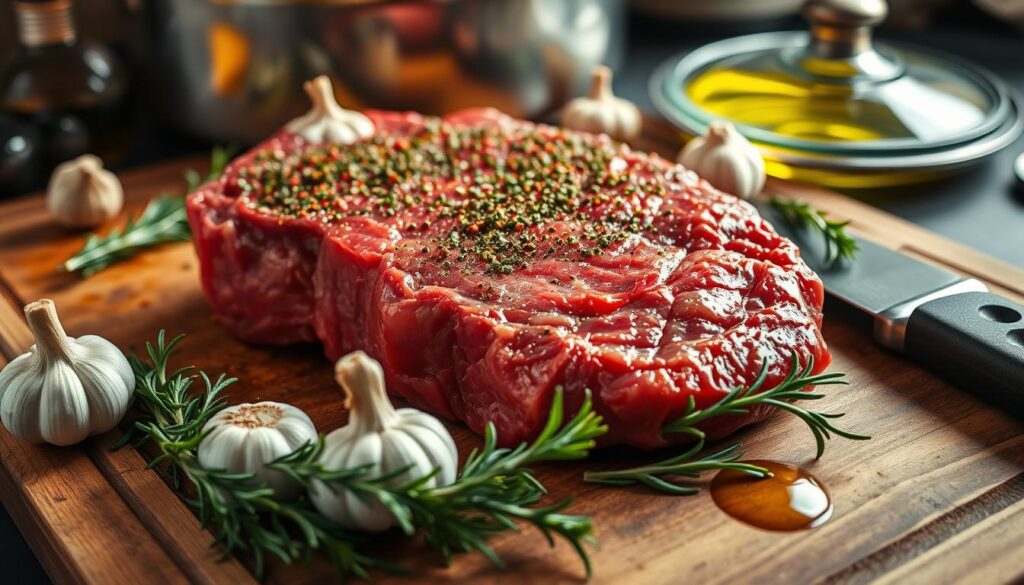
Meat Temperature Guidelines
For the best steak, take it out of the fridge 30 minutes before cooking. This lets it get to room temperature, so it cooks evenly. Here’s a temperature guide for different doneness levels:
| Doneness | Internal Temperature |
|---|---|
| Rare | 125°F (52°C) |
| Medium Rare | 135°F (57°C) |
| Medium | 145°F (63°C) |
| Well Done | 160°F (71°C) |
Marination Techniques
Spanish cooking loves simple yet tasty marinades. Mix olive oil, garlic, and herbs like thyme and rosemary. Let your steak marinate for 2-4 hours. This boosts its flavor without hiding the meat’s taste.
Pre-cooking Preparation Steps
Before grilling, dry the steak with paper towels. This is key for a great sear. Season it well with salt and black pepper. For a Spanish twist, add some smoked paprika before grilling.
“The secret to a great steak lies in its preparation. Respect the meat, and it will reward you with incredible flavor.”
By following these tips, you’ll make grilled meat dishes that are top-notch. They’ll show off the best of Spanish cuisine.
Mastering the Grilling Process
Grilling is an art in Spanish cuisine, with beef recipes leading the way. We’ve honed the technique for the best grilled meat experience. The secret is in controlling the temperature and timing.
Begin by heating your grill to 450°F to 500°F. This high heat gives a nice sear on the outside and keeps the inside juicy. Grill a medium-rare steak for 4-5 minutes on each side. Use a meat thermometer to check the internal temperature – 135°F is perfect for medium-rare.
After grilling, let the steak rest for 5-10 minutes. This lets the juices spread, making the meat more flavorful and tender. While waiting, prepare your Romesco sauce, a great match for grilled Spanish steak.
“The secret to a perfect grilled steak is patience and precision. Don’t rush the process, and always respect the meat.”
Here’s a quick guide to steak doneness:
| Doneness | Internal Temperature | Grill Time (per side) |
|---|---|---|
| Rare | 125°F | 3-4 minutes |
| Medium-Rare | 135°F | 4-5 minutes |
| Medium | 145°F | 5-6 minutes |
| Well-Done | 160°F | 8-10 minutes |
Remember, these times can change based on steak thickness and grill heat. Always check with a thermometer for the best results.
Spanish Steak with Romesco Sauce
Let’s explore this tasty beef recipe. Spanish Steak with Romesco Sauce is a key part of tapas. It combines rich flavors and textures. We’ll show you how to cook, plate, and serve it like a pro at home.
Step-by-Step Cooking Instructions
First, season your steak with salt and pepper. Heat a cast-iron skillet over high heat until it smokes. Cook the steak for 3-4 minutes on each side for medium-rare.
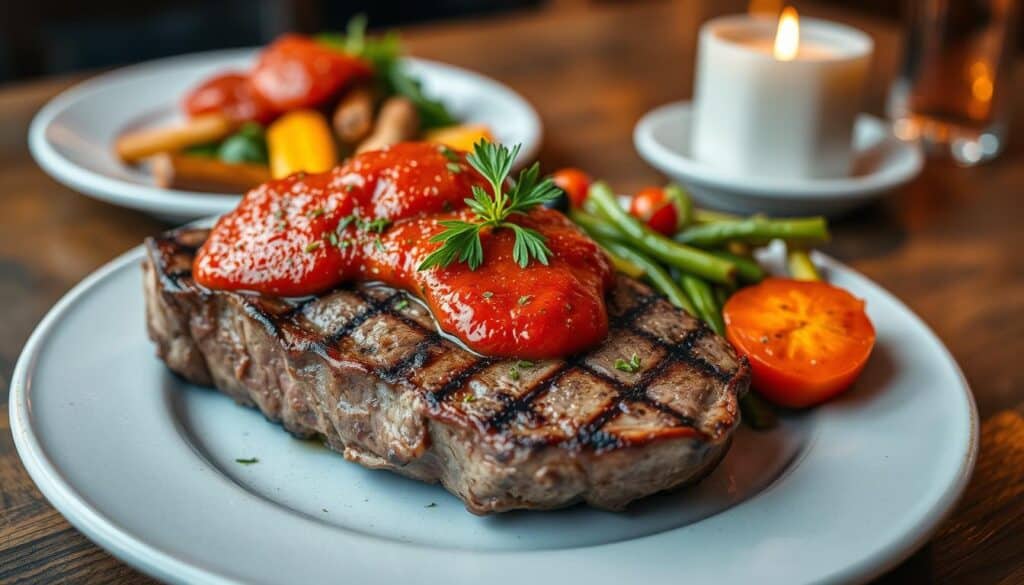
Plating Techniques
To plate like a pro, slice the steak against the grain. Place a big spoonful of Romesco sauce in the center of the plate. Put the steak slices on top, slightly overlapping.
Garnish with fresh herbs and a drizzle of olive oil for a final touch.
Serving Temperature Recommendations
Serve your Spanish Steak with Romesco Sauce warm, not hot. The steak should be about 130°F (54°C) for medium-rare. The Romesco sauce should be warm but not too hot.
This temperature balance lets the flavors mix perfectly.
| Component | Ideal Temperature | Resting Time |
|---|---|---|
| Steak | 130°F (54°C) | 5-10 minutes |
| Romesco Sauce | Warm | No rest needed |
By following these tips, you’ll make a Spanish Steak with Romesco Sauce that’s just like tapas bar food. This beef recipe will wow your guests and take them to Spain’s lively food scene.
Perfect Wine Pairings and Accompaniments
Spanish food is amazing with the right wines and sides. Our Spanish steak with Romesco sauce needs the perfect match. We’ll look at great wine pairings and traditional sides to make your meal better.
Spanish Red Wine Selections
The bold flavors of Spanish steak need strong red wines. Rioja’s oak-aged taste goes well with the meat’s savory flavors. Tempranillo wines from Ribera del Duero add fruity notes that balance the Romesco sauce.
For a richer taste, try Priorat. Its intense mineral flavor is perfect.
| Wine Region | Grape Variety | Flavor Profile |
|---|---|---|
| Rioja | Tempranillo | Oak, vanilla, red fruits |
| Ribera del Duero | Tempranillo | Black fruit, spice, tobacco |
| Priorat | Garnacha, Cariñena | Blackberry, licorice, mineral |
Traditional Side Dishes
Pair your steak with classic Spanish sides. Patatas bravas, crispy potatoes with spicy tomato sauce, add a nice crunch. Grilled veggies like eggplant and zucchini bring a smoky flavor.For refreshing pairings, explore our Dessert & Juices Collection, filled with creative drink options to complement this dish. View Recipes.
For a true tapas feel, serve Manchego cheese and Jamón ibérico with your steak.
Finding the perfect wine pairing is all about balance. A bold Tempranillo pairs well with the steak’s richness. A fruity Garnacha complements the Romesco sauce’s nutty taste. Try different wines to find your favorite match in Spanish cuisine.
Tips for Achieving Restaurant-Quality Results
To make your Spanish dishes at home better, pay close attention to details. We’ve got key tips to help you make your beef recipes as good as those in restaurants. These tips will turn your grilled meat into Spanish culinary art.
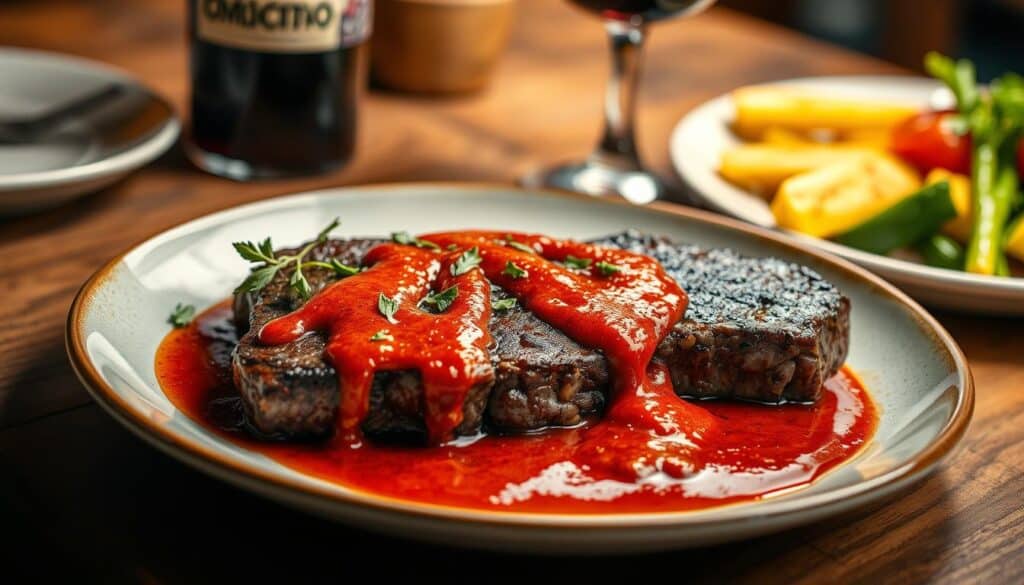
Start by picking the best beef for your Spanish steak. Choose cuts like ribeye or sirloin that are well-marbled. Make sure the meat is at room temperature before cooking for even cooking.
Season it well with sea salt and black pepper.
To get a great sear, heat your grill or skillet until it’s very hot. This method keeps the juices in and adds flavor. Cook your steak to medium-rare for the best taste and texture.
For the romesco sauce, use the best ingredients. Roast red peppers and tomatoes to make them taste better. Toast almonds and hazelnuts to add nutty flavor. Blend everything until it’s smooth for a creamy sauce.
| Ingredient | Quality Tips |
|---|---|
| Beef | Choose grass-fed, well-marbled cuts |
| Peppers | Use ripe, fire-roasted red peppers |
| Nuts | Toast almonds and hazelnuts for depth |
| Olive Oil | Select extra-virgin Spanish olive oil |
How you present your dish is important in Spanish cuisine. Cut the steak against the grain and place it nicely on a warm plate. Drizzle romesco sauce over it or serve it on the side. Add fresh herbs like parsley or thyme for color and smell.
Common Mistakes to Avoid
Getting Spanish Steak with Romesco Sauce right needs focus. We’ve found main mistakes in beef and grilled meat. Let’s look at these to make your cooking a hit.
Temperature Control Issues
Controlling heat is key for Spanish Steak with Romesco Sauce. Uneven cooking happens if the temperature is off. Use a good thermometer to check your grill’s heat. Aim for 450°F for a great sear. Let your steak rest before slicing to keep the juices in.
Sauce Consistency Problems
Romesco sauce is vital for your dish. To avoid a watery sauce, roast peppers and tomatoes well. Blend slowly, adding oil little by little for a smooth mix. If it’s too thick, add a bit of water or broth.
Timing and Coordination Challenges
Timing steak and sauce right is an art. Start the Romesco sauce before grilling. While the steak rests, warm the sauce a bit. This way, both are ready at the same time, making your Spanish Steak better.
By avoiding these common mistakes, you’ll make a top-notch Spanish Steak with Romesco Sauce. Remember, the more you practice, the better you’ll get at beef and grilled meat.
Conclusion
Spanish cuisine is full of flavors. Our journey through Spanish steak with Romesco sauce shows its rich traditions. This beef recipe is a true taste of Spanish cooking.
It combines tender meat with a vibrant sauce. This sauce is great for tapas or main courses.
We looked at the cultural roots of this dish. It comes from Catalonia and is loved in modern Spanish cooking. The right ingredients, grilling, and making Romesco sauce make it special.
Learning this recipe lets you bring Spain’s flavors to your home. It’s perfect for a tapas night or a new beef dish. Try it and enjoy the flavors of Spanish cuisine in your kitchen.

